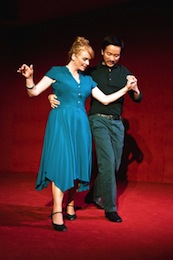Shibari, the Japanese practice of rope bondage informs both form and content of Gary Duggan’s new play. The plot tells of a group of present-day multicultural Dubliners who both strain against and submit to the ties of family, relationships and grief. Reflecting the current national mood these characters seek command of and order in a world that seems beyond their control. A succession of short well-paced scenes reveals how these characters are all knotted to each other’s fate. The piece is beautifully wound, and the production, its writing, direction by Tom Creed and acting are tight – but the overall experience (much like an extended metaphor) felt forced and too controlled.
 Frank Conway’s set design consisted of the iconographic Irish country kitchen (hearth, kitchen table, sacred heart and votive light) hung upside down from the ceiling and washed over with a deep opulent red paint. This announced a bold statement of intent: Here is a new Irish play commissioned by Ireland's National Theatre that seeks to break with the tradition of the peasant plays set in rural cottages, turn it on its head and offer instead a hip, urban, contemporary representation of Dublin.
Frank Conway’s set design consisted of the iconographic Irish country kitchen (hearth, kitchen table, sacred heart and votive light) hung upside down from the ceiling and washed over with a deep opulent red paint. This announced a bold statement of intent: Here is a new Irish play commissioned by Ireland's National Theatre that seeks to break with the tradition of the peasant plays set in rural cottages, turn it on its head and offer instead a hip, urban, contemporary representation of Dublin.
On this front the play delivers a cast of characters that includes a Romanian bookseller, Ioana (a charming Alicja Ayres) and a Japanese florist, Hideo (a meek Orion Lee) who both have happily made Dublin their home; a celebrity Afro-English movie star, Nick, slumming it in an Irish theatre to gain credibility (a cocky but endearing Michael Yare), and three dissatisfied Dublin-born siblings: a recently widowed restaurant hostess, Marie (a vulnerable Janet Moran), an already-jaded young journalist Liam (a likeable Ian Lloyd Anderson) and a self-destructive sales team leader, Eva (a fearsome Kate Nic Chonaonaigh). There is not a parish priest, a local teacher or land-hungry farmer in sight; the cast are all dressed by Eimer Ní Mhaoldomhnaigh in bright monochromatic outfits, and the only tea consumed is Long Island Iced Tea cocktails.
The characters are not confined to one room but instead inhabit, amongst other spots, an advertising sales office, flower shop, sauna, and a private booth in a karaoke bar. These locations are nicely suggested by Sarah Jane Shiels' lighting design and a combination of simple brought-on props, the clever repeated use of a stark illuminated bench, and Jack Phelan’s atmospheric but unobtrusive projections.
 So far, so urban – but whenever the city of Dublin is referenced in the dialogue it is spoken of as though it were a village. We are told it is a small place, “a pretend city” characterised by the fact that everyone knows everyone else. What binds all the disparate characters together is an Irish family and the driving action is dependent on the old device of an outsider figure arriving and disrupting family relations – the favoured dramaturgical structure for such defining peasant plays as Yeats and Gregory’s Cathleen ni Houlihan and Synge’s The Playboy of the Western World. Admittedly, and appropriately, in a contemporary play the outsider figure is rendered complex. Nick, Hideo and Ioana are all outside of the family and outside of an Irish ethnicity, but in the case of Hideo and Ioana their outsider status is complicated by their articulated sense of belonging to contemporary Dublin.
So far, so urban – but whenever the city of Dublin is referenced in the dialogue it is spoken of as though it were a village. We are told it is a small place, “a pretend city” characterised by the fact that everyone knows everyone else. What binds all the disparate characters together is an Irish family and the driving action is dependent on the old device of an outsider figure arriving and disrupting family relations – the favoured dramaturgical structure for such defining peasant plays as Yeats and Gregory’s Cathleen ni Houlihan and Synge’s The Playboy of the Western World. Admittedly, and appropriately, in a contemporary play the outsider figure is rendered complex. Nick, Hideo and Ioana are all outside of the family and outside of an Irish ethnicity, but in the case of Hideo and Ioana their outsider status is complicated by their articulated sense of belonging to contemporary Dublin.
Here, then, the play would seem not to forge any radical break with the Irish plays of the past and, despite its intricate design, the play shows little innovation in terms of theatrical presentation: all the characters, situations and dialogue are naturalistic and perhaps more suited to a television format. With a lack of theatricality in the play, all emphasis falls on plot and character. But it is hard to invest in these characters as they do not develop and are not rendered complex enough in the writing. The plot may be full of knots but these are part of a taut weave that leaves no loose ends. Both character and plot are bound by the constricted form of the play.
Ultimately, much like the Japanese ikebana flower arrangements that feature in this production we can admire the precision and craft on display but the effect seems overwrought. In a play where the characters on stage continually seek to be numbed from the world it is the audience who are finally left cold. Here form and content are tied so tightly together in the overall shibari design that they strangle each other and rob the play of life.
Dr. Ian R. Walsh lectures in Drama Studies at University College Dublin.